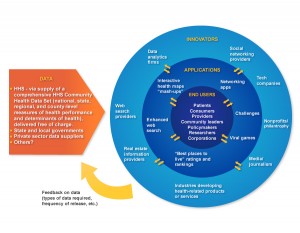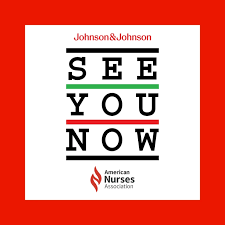 The U.S. boasts the greatest number of MRIs and PET scanners per capita; pharmacies packed with numerous statins all of which accomplish just about the same thing; and, plenty of neurosurgeons to serve the U.S. population and a few other nations simultaneously.
The nation also has among the poorest track records for infant mortality in the developed world; a growing burden of chronic disease among both the old and youngest health citizens; lack of adherence to evidence-based medical protocols; and a citizenry with a growing hunger for health empowerment, engagement and control.
There’s a resource that’s not yet been fully deployed in the U.S. that could lead to truly new-and-improved health for the nation: the rich goldmine of health data that’s been virtually locked in data silos in both public and private sectors.
These bits and bytes of data can be harnessed to improve the public’s health, individually and collectively. That’s the objective of the Community Health Data Initiative from the Department of Health and Human Services. Today, the initiative launched in person and via webcast from Washington, DC.
Harvey Fineberg, President of the Institute of Medicine (IOM), told the crowd attending the kick-off, “Information stands at the crossroads of everything we care about in health,” from advancing health to keeping people healthy. Fineberg introduced the meeting, highlighting, “the ways that public and private sectors are working together that can make information relevant, available, usable, and valuable in advancing health.”
Emphasizing the timeliness and importance of the effort, Fineberg pointed to a key driver for this initiative, Todd Park — “We are marching to Todd Park’s timeline which is QuickTime.” His job at HHS is to “unlock the data reservoir,” as Secretary Sebelius described it.
Secretary Sebelius told the group that health reform meets open government when it gives health citizens choice, through providing better information–“and HHS has a lot of data,” she said, listing the many agencies where data resides: AHRQ, CDC, CMS, FDA, and many others.
The graphic illustrates the framework for this project. At the center sit end-users: patients, consumers, providers, community, researchers, companies. These users are surrounded by apps they can access based on their own demands, which are created by “innovators” which surround the entire ecosystem — which can be virtually any interested party, from for-profit technology companies to media, not-for-profit advocacy organizations, and passionate individuals managing chronic conditions. The data come from the Federal government — the Department of Health and Human Services — as well as State and local governments. In addition, private plans, pharmacies and pharmacy benefit managers, and other private sector organizations who hold health data can provide data.
This project is part of the HHS Open Government Plan, which you can read and comment on at this website.
Health Populi’s Hot Points: What’s been exciting in the short-time since this project was brainstormed in March 2010 — a less than 3 months’ time lapse — is seeing the number and quality of projects this effort has inspired. The momentum is impressive, and represents the pent-up demand for Open: transparency, and access to health data heretofore locked up in virtual cabinets.
Silos-‘R-Us no longer works in health. This project has let the health data genie out of the bottle. Watch out for an upcoming “hack-a-thon” this fall 2010 and numerous other projects that will be announced via Twitter, on the HHS Open website, and wherever you find folks innovating solutions for the health citizens.]]>
The U.S. boasts the greatest number of MRIs and PET scanners per capita; pharmacies packed with numerous statins all of which accomplish just about the same thing; and, plenty of neurosurgeons to serve the U.S. population and a few other nations simultaneously.
The nation also has among the poorest track records for infant mortality in the developed world; a growing burden of chronic disease among both the old and youngest health citizens; lack of adherence to evidence-based medical protocols; and a citizenry with a growing hunger for health empowerment, engagement and control.
There’s a resource that’s not yet been fully deployed in the U.S. that could lead to truly new-and-improved health for the nation: the rich goldmine of health data that’s been virtually locked in data silos in both public and private sectors.
These bits and bytes of data can be harnessed to improve the public’s health, individually and collectively. That’s the objective of the Community Health Data Initiative from the Department of Health and Human Services. Today, the initiative launched in person and via webcast from Washington, DC.
Harvey Fineberg, President of the Institute of Medicine (IOM), told the crowd attending the kick-off, “Information stands at the crossroads of everything we care about in health,” from advancing health to keeping people healthy. Fineberg introduced the meeting, highlighting, “the ways that public and private sectors are working together that can make information relevant, available, usable, and valuable in advancing health.”
Emphasizing the timeliness and importance of the effort, Fineberg pointed to a key driver for this initiative, Todd Park — “We are marching to Todd Park’s timeline which is QuickTime.” His job at HHS is to “unlock the data reservoir,” as Secretary Sebelius described it.
Secretary Sebelius told the group that health reform meets open government when it gives health citizens choice, through providing better information–“and HHS has a lot of data,” she said, listing the many agencies where data resides: AHRQ, CDC, CMS, FDA, and many others.
The graphic illustrates the framework for this project. At the center sit end-users: patients, consumers, providers, community, researchers, companies. These users are surrounded by apps they can access based on their own demands, which are created by “innovators” which surround the entire ecosystem — which can be virtually any interested party, from for-profit technology companies to media, not-for-profit advocacy organizations, and passionate individuals managing chronic conditions. The data come from the Federal government — the Department of Health and Human Services — as well as State and local governments. In addition, private plans, pharmacies and pharmacy benefit managers, and other private sector organizations who hold health data can provide data.
This project is part of the HHS Open Government Plan, which you can read and comment on at this website.
Health Populi’s Hot Points: What’s been exciting in the short-time since this project was brainstormed in March 2010 — a less than 3 months’ time lapse — is seeing the number and quality of projects this effort has inspired. The momentum is impressive, and represents the pent-up demand for Open: transparency, and access to health data heretofore locked up in virtual cabinets.
Silos-‘R-Us no longer works in health. This project has let the health data genie out of the bottle. Watch out for an upcoming “hack-a-thon” this fall 2010 and numerous other projects that will be announced via Twitter, on the HHS Open website, and wherever you find folks innovating solutions for the health citizens.]]>
The wealth in health data – DHHS's Community Health Data Initiative
By Jane Sarasohn-Kahn on 2 June 2010 in Electronic health records, Health care information technology, Health Consumers, Health reform, Health social networks, Internet and Health, Public health




 Hackathons are intense, fast-paced events where interdisciplinary teams come together to solve complex problems. In this SEE YOU NOW Insight from
Hackathons are intense, fast-paced events where interdisciplinary teams come together to solve complex problems. In this SEE YOU NOW Insight from  I'm once again pretty gobsmackingly happy to have been named a judge for
I'm once again pretty gobsmackingly happy to have been named a judge for  Stay tuned to Health Populi in early January as I'll be attending Media Days and meeting with innovators in digital health, longevity, and the home-for-health during
Stay tuned to Health Populi in early January as I'll be attending Media Days and meeting with innovators in digital health, longevity, and the home-for-health during